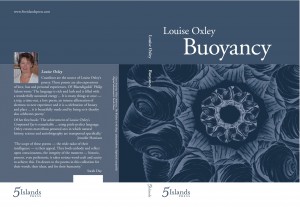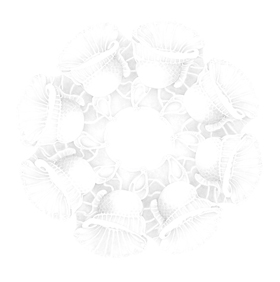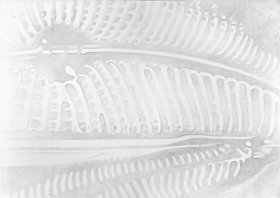Poetry
we are from the Ocean – do we remember in our cells?
saltwater dreams by Megan Schaffner 2009
underwater
on the edge of no-breath
I dive down
to a time before no-time
when my cells floated free
oscillated in warm seas
as whales plunge
and spout
across the horizon
sounding
their ancient songs
I taste the salty moment
when hair and nails
were protective scales
feet and fingers
fused to flippers
emerging at the edge of the Bight
evolving from fish to mammal
I graze on succulent leaves
and in a flash of recognition
beyond imagination
know them to be life-giving.
Some respond to change in a once unassailed land, far south . . .
Sailing in to Antarctica by Pauline Bindoff
Cold so visible
assails the eyeballs
and lids droop.
Breath slows,
Subtly solidifies.
Hoar frost forms
On eyebrows,
beards
and nostrils.
But this cold,
Closing in on us
Is other to the icebergs.
Their life forms depend
On the exclusion
Of that which we bring.
Encountered now,
passing by
our warmth.
Watching
we fall silent
foreseeing the end.
In the Beginning was the Word
But here they falter,
Somehow sacrilegious –
The sound of warmth
Hastening that silent conversion
Of proud prism to freshwater lens.
No longer real
not surreal,
but other.
or make comment on silent change . . .
Unfathomable by Pauline Bindoff
The well is deep
It listens endlessly
As the sounds fall
Disturbing nothing
Seemingly,
In the long descent.
Fathomless
The well stays deep
And listens still.
Sounds thump
Clump – come to rest,
Seemingly
In the long accumulation.
Fathomed
The well waits now
Aware
Its ability to unchange
Able no longer.
Poets respond to science
Exhibitions which pair the visual arts and poetry have become popular. Here Tasmanian poets Adrienne Eberbard and Louise Oxley respond to planktonic forms – plankton, the wandering plants of the ocean, described in Plankton – a Critical Creation by Gustaaf Hallegraeff, and the fabulous radiolarian forms first described by Ernst Haeckel in 1862.
Adrienne Eberhard
Adrienne Eberbard’s first collection of poems Agamemnon’s Poppies was published in 2003, followed by Jane, Lady Franklin in 2004 and the Wagtail chapbook No. 47, Phospherescent and other Poems in 2005 by Picaro Press. The Bells (Ornithocercus steinii) appears in Adrienne’s poetry collection This Woman, (2011), published by Black Pepper and was a response to the drawing The Wisdom in the Ring – Ornithocercus steinii, by Sue Anderson.
The Bells (Ornithocercus steinii)
A 21st century boy sits bewitched,
not by his own reflection
but by the luminous sea, lit from within
like a lantern, pulsing with indigo fire.
He gathers mouthfuls of spit
to lob like bombs, that explode
in an excoriation of silver,
the water, a series of illuminated chambers
he aches to enter and explore;
as he experiments with his foot,
and feels it turn to mercury,
his body flames with a wild desire
to both swim and fly.
The sea he trawls with his toes
is thick as pasture, a grazing ground
fed by the wash of its own liquid body
begun millenia ago
when the ocean was newly-born,
and by the sun’s rich rays,
its fingertips bearing a Midas touch.
When the boy is statue-still long enough
he might sense the song
of a million micro-organisms,
each single-celled and spinning,
a collective – catching carbon,
releasing oxygen, absorbing sunlight,
seeding the clouds that cool the earth –
their dance an act of intelligence
equal to his own quizzical wonder
at this bright, night, Galilean world
showering blue light at his feet.
If his imagination is acute, he will hear
the tinkling of tiny bells
spiralling in warm, tropical waters,
flagella propelling them
like whirling whips, each set of eight
a ring of promise or a wreath of grief,
an exhalation of air for him to breathe
or a blood tide smearing the sea,
smothering their own, and his, song.
He is hearing inflections now, tuning
to the bells’ frequency, the sound
cleaner, truer, and as he tilts his head
he knows they could be warning bells
oscillating between peal and toll.
As they spin closer, what does he see:
the diaphanous wings of a bridal dress
trailing its embroidered veil;
the delicate rim of a translucent chalice
to lift to his lips and drink;
the louvre and effortless lift
of a bird’s tail;
the gossamer rain of a parachute
offering flight.
Louise Oxley
Louise is a Hobart poet for whom the sea is a powerful and pervasive force. She is the recipient of several prizes, including the Bruce Dawe, Tom Collins and Banjo Paterson Awards. Her collection, Compound Eye (Five Islands Press, 2003) was commended in the FAW Anne Elder Award. A small selection of her work also appears as Sitting with Cezanne (Wagtail 41, Picaro Press, 2005). The poem The Challenger Radiolarians, a response to Art Forms From the Ocean: The Radiolarian Atlas of 1862 of Ernst Haeckel, is included in the collection Buoyancy published by Five Island Press in 2008 and was a response to visual art work by Sue Anderson. 
The Challenger Radiolarians
Wade through the surf. It is breaking.
No, really, it is breaking. They are heavy sighs,
drawn on a rattling in-breath
of shellshards and gravel.
Stand in the shallows and listen.
The water is cold, but not as cold
as it was yesterday, and it is rising.
Waves thump at your knees and thighs,
push and foam at your pubis, navel, breast.
They lick at your throat. Remain on the seabed.
It is the floor of truth.
The sea wants to be intimate with you. Open.
Let it in. Everybody needs inside them an ocean or a river.
Besides, you are already made of saltwater
and measured by tides. They write calendars of blood.
Your children depend on them.
The tongue is a cradle.
Lay our names there and rock them:
Thalassacolla pelagica, Acanthometra fragilis, Collozoum inerme,
Dictopodium trilobum, Arachnocorys circumtexta.
We will speak for you now
even if you put a hand over your mouth to stop us.
* Thalassacolla pelagica (I:1)
This is a salty nipple. Suck.
It is a disc of wafer to crackle and soften
against the tessellated ceiling of your mouth.
Kneel and take it on your tongue.
Let it lie there melting. It is a lozenge
of exquisite colour and sweetness. Swallow.
* Acanthometra fragilis (XV:4)
This is the sultan’s horoscope,
the Mongol’s frescoed observatory,
the geometer’s joy. Spin it and watch
the heavens revolve day and night like a potter’s wheel.
It’s the music of the spheres,
the explanation and working of all things.
It seems you have appointed yourself timekeeper.
Did you say you were the sultan,
at the centre of the empire like the sun,
dispensing patronage and wisdom?
* Collozoum inerme (XXXV:1)
This is frogspawn, another kind of clock.
All of the numbers for measuring time
– millennia to nano-seconds –
are held here. Become the brown-limbed child
who squats at the edge of the pond
and guddles for spotted jelly.
Let the slimy bubbles slip between your fingers.
Now practise leaving them be.
* Dictopodium trilobum (VIII:6)
Are they lobes of the brain or heart
that fatten like some exotic succulent
behind the perforated armour of this falcon’s hood?
Strap it against your throat; you’ve flown far enough.
Now that you’re pinned down and blindfold
shoulder your predator’s wings
and listen to the dry rasp of settling feathers.
* Arachnocorys circumtexta (VI:9)
Allow the terrible vivacity of spiders
out of your dark corners. Here is one
in a halo of fractured light,
her rearing forelegs threading, crystal by crystal,
a glass pavillion. It’s a fragile and dangerous geometry.
A puncture-wound, a blister of fear
may be what you need.
* Love is the great Asker. What will your answer be?
Our Buttoned Lips are Yours – Diatome Fumi Po.

